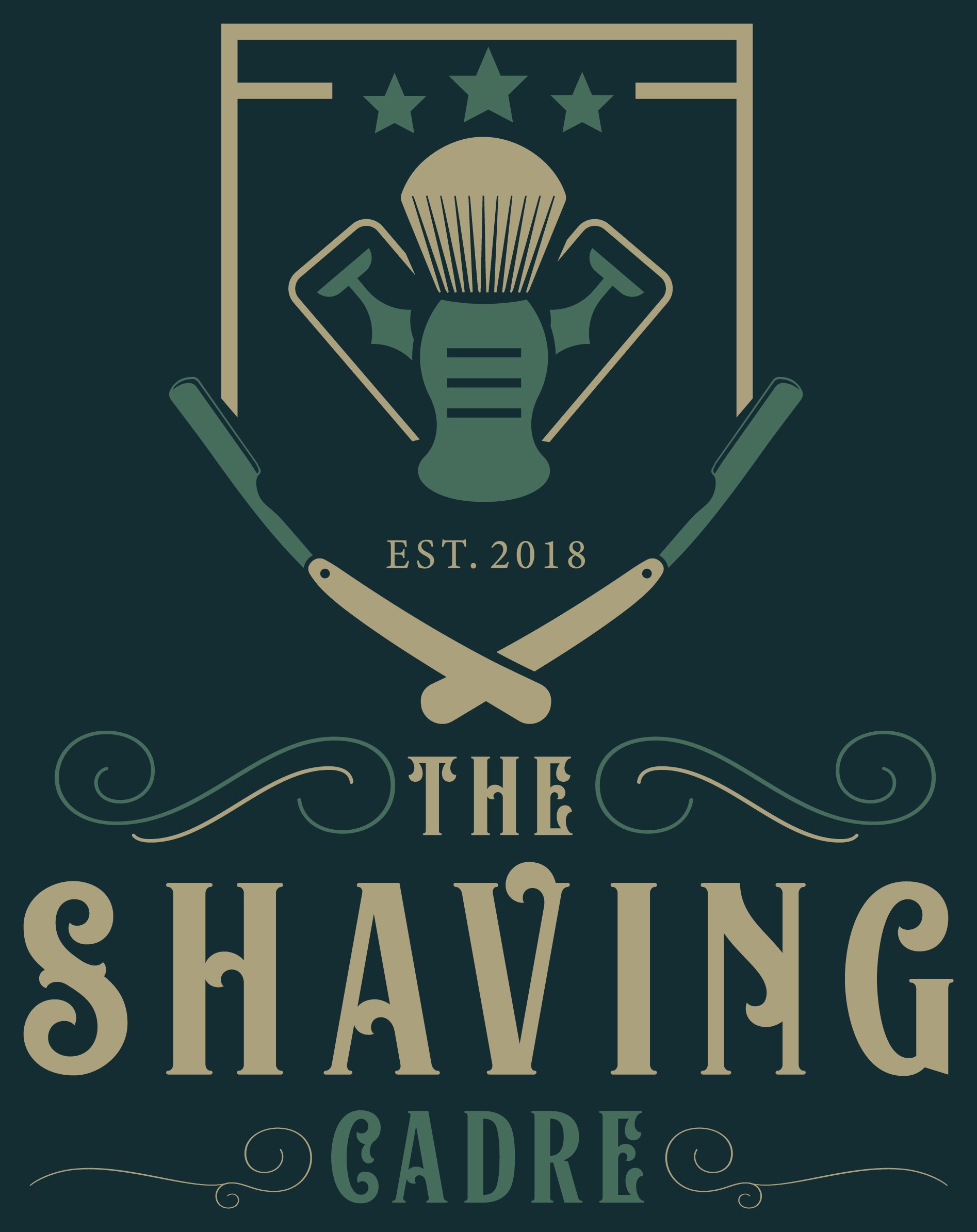The Shaving Cadre
You are using an out of date browser. It may not display this or other websites correctly.
You should upgrade or use an alternative browser.
You should upgrade or use an alternative browser.
An Unexpected Journey: A Newbie's Walk In Wet Shaving
- Thread starter Blade-meister
- Start date
Fascinating finds - I really enjoy these!
BTW, if you think cold shaves are great - treat yourself to a mentholated soap!
have a great night!
BTW, if you think cold shaves are great - treat yourself to a mentholated soap!
have a great night!
Yeah, I hate cold showers and being cold in general. I know that sounds funny being I live in the north. I'd rather face a lot of things, but a body of cold water I dislike a lot. I can tough my way through it, but it doesn't mean I gotta like it.Glad you’re getting that cold shower issue fixed…
I've been cold shaving for a while actually and prefer it. I thought I'd love the menthol soaps, but they irritate my face for some reason. I enjoyed the super cool feeling, but it gave me redness so there wasn't much of an upside. What I've observed with cold water shaving is that I get a closer shave. I guess the working theory is that the hair follicles stand-up prouder with the cold so you shave off more of the whisker so when your face gets room temp the hair follicle opens up and what's left of the hair sinks down further.......or at least that's what I was told. Maybe now the SR can come off the bench. No way I was going to take that in for the shower shaveBTW, if you think cold shaves are great - treat yourself to a mentholated soap!
On the shaving front...............I do believe I'm back to shaving normally again. I just can't get over how good the shaves feel and I forgot just how close of a shave I get with the cold water shaving. I get better lathers too. I am having an issue lathering the Williams Mug soap lately. I get a nice creamy lather in the bowl and when I get out of the shower it's just foam bubbles that need reviving. I wonder if my brush is just worn out? I'll try a few more brushes to see.
Here's a few pictures of Letchworth State Park up here in NY. It's called the Grand Canyon of the east and it is a nice place to visit if you are ever up in NY.
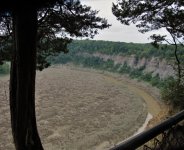
You can see the brown area by the Genesee River in the above picture. Those are all small trees and brush that are normally green, but that area saw some pretty heavy flooding a few weeks prior to this picture so all that area was covered in flood water up to the green treeline on the canyon wall.
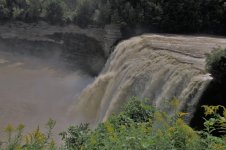
At the western most end of the park there are falls that are pretty to see. These still look pretty angry from all the rain and flooding.
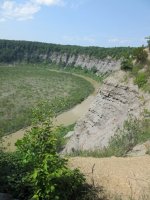
Here's a picture from 3 years ago that shows it without the flooding. Believe it or not, Letchworth has rattlesnakes and turkey vultures. Here's proof of the rattlesnakes taken at Letchworth Park by one of my flintknapping mentors:
Labor day usually involves me laboring all day at one project or another, but not this Labor Day! I got out in the morning to do a little metal detecting at a friend's house. I had his two boys tagging around with me, but hey, it's the cost of admission  Here's more finds:
Here's more finds:
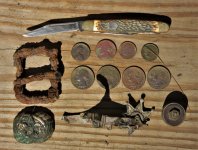
The very first signal was the Boy Scout neckerchief slide holder. It's seen a rough time of it in the ground for many years. The second signal was the Kutmaster pocket knife up top. Kutmaster is made by Utica Knife Company in NY and this one dates from the 1950's probably. I think is was lost later due to how well it survived. At the bottom is what is left of one half of a set of Lone Star Rider children's spurs from the 1960's. The oldest coin there is a 1940 Jefferson Nickel. At the bottom right is a solid brass fitting of some kind that I will save as brass stock for knife making someday. The oldest item there would be the rusty metal belt buckle. Judging from the rust crust it must be 1800's.
I put the knife in the electrolysis tank for about an hour and a half and it got cleaned up really nice. I was able to get the 2 other blades free and moving, but more oiling needs to happen to see if the bottom tension bars will slide free again so the blades will be tight when in the open position. This pocket knife was 6 inches down so it was lost a long time ago and is a testament to stainless steel or whatever this steel is. Here's the rust I was dealing with:
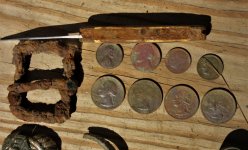
I had the belt buckle in the tank for all of last evening and it's coming along. It will probably take a few nights of time in the tank to get it down to something that looks like a belt buckle. The center hook is made from wrought iron because I can see the grain peeking through in one spot and wrought iron has a grain like wood fibers. In the end I hope it comes out well enough so I can get the center hook free and moving so I can use it as an example for forging my own belt buckles someday. I'll post pictures of the buckle and knife all cleaned up.
After supper we got out for a nice fire at the cabin. The firemaster is pictured below I had the Indian flute out there along with my belt axe / mountain man knife. It was nice to absorb the peace of "God's TV" and the woods with my family. Played my flute and called in a chipmunk who's cheeks were stuffed right full, but he was wondering what it was. He got in the cabin once when I was working out there last year and I had to show him that he didn't belong in there so he's been quite happy in his little ground tunnel system that has many little escape holes here and there. It was nice to decompress out there and be home with the family, life has been stressful in the past few weeks.
I had the Indian flute out there along with my belt axe / mountain man knife. It was nice to absorb the peace of "God's TV" and the woods with my family. Played my flute and called in a chipmunk who's cheeks were stuffed right full, but he was wondering what it was. He got in the cabin once when I was working out there last year and I had to show him that he didn't belong in there so he's been quite happy in his little ground tunnel system that has many little escape holes here and there. It was nice to decompress out there and be home with the family, life has been stressful in the past few weeks.
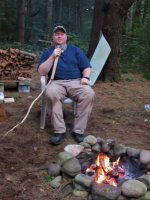

The very first signal was the Boy Scout neckerchief slide holder. It's seen a rough time of it in the ground for many years. The second signal was the Kutmaster pocket knife up top. Kutmaster is made by Utica Knife Company in NY and this one dates from the 1950's probably. I think is was lost later due to how well it survived. At the bottom is what is left of one half of a set of Lone Star Rider children's spurs from the 1960's. The oldest coin there is a 1940 Jefferson Nickel. At the bottom right is a solid brass fitting of some kind that I will save as brass stock for knife making someday. The oldest item there would be the rusty metal belt buckle. Judging from the rust crust it must be 1800's.
I put the knife in the electrolysis tank for about an hour and a half and it got cleaned up really nice. I was able to get the 2 other blades free and moving, but more oiling needs to happen to see if the bottom tension bars will slide free again so the blades will be tight when in the open position. This pocket knife was 6 inches down so it was lost a long time ago and is a testament to stainless steel or whatever this steel is. Here's the rust I was dealing with:

I had the belt buckle in the tank for all of last evening and it's coming along. It will probably take a few nights of time in the tank to get it down to something that looks like a belt buckle. The center hook is made from wrought iron because I can see the grain peeking through in one spot and wrought iron has a grain like wood fibers. In the end I hope it comes out well enough so I can get the center hook free and moving so I can use it as an example for forging my own belt buckles someday. I'll post pictures of the buckle and knife all cleaned up.
After supper we got out for a nice fire at the cabin. The firemaster is pictured below

Nothing cooler than an old pocketknife. Great pictures!
Wowza! What a find with that pocket knife! Great job giving it some new life
Yeah that knife sorta surprised me because it was shiny and most things you dig are rusty and trash, so yeah Wowza is right! This is the third pocket knife I've found this year and each one is progressive in it's condition. I'll have to take a photo of each knife because they kind represent bad, good, and great condition statuses. I also found a lot of lead pieces there too. Big hunk of lead pipe and lots of little bits of lead. I save it all. It scraps easy, but lead may be in short supply at some point so it might be handy to have around.Nothing cooler than an old pocketknife. Great pictures!
On the metal detecting front, I got out Saturday morning and hit a friend's front lawn where I found my first silver coin. The last time I detected that area was in the spring when I was really new at it. I found a lot of modern coins and the silver Mercury Dime. I thought I'd done an excellent job.............well, now that I'm more experienced I went over the same area and found a ton more coins and my first 1800's coin. More on that in a future post.
Here's the clean-up pictures of the knife and belt buckle I found on my last outing.
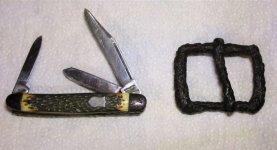
I've been carrying the pocket knife this past week to give it some pocket polish. The buckle is still pretty rough, but that tells me it's been in the ground a long time so it's likely 1800's. It could be a colonial shoe buckle, but I'm leaning that it's not because most of those were made of brass. But, check out the before and after pictures of the buckle:
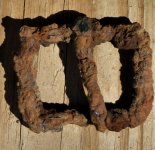
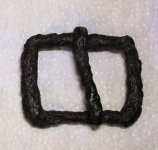
As you can see, the buckle went on a massive diet in the electrolysis tank. I think what I love the most about this process is that most guys would toss this buckle in the scrap bin but I've saved it for future generations to enjoy. You can see it was hand forged in this picture:
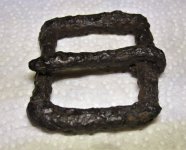
Just a simple wrought iron center latch in the middle that was bent around the buckle. This was a poor man's buckle for sure, and I like that. I'm like that too, I don't have the best stuff but do what I can with what I have.
Here's the clean-up pictures of the knife and belt buckle I found on my last outing.

I've been carrying the pocket knife this past week to give it some pocket polish. The buckle is still pretty rough, but that tells me it's been in the ground a long time so it's likely 1800's. It could be a colonial shoe buckle, but I'm leaning that it's not because most of those were made of brass. But, check out the before and after pictures of the buckle:


As you can see, the buckle went on a massive diet in the electrolysis tank. I think what I love the most about this process is that most guys would toss this buckle in the scrap bin but I've saved it for future generations to enjoy. You can see it was hand forged in this picture:

Just a simple wrought iron center latch in the middle that was bent around the buckle. This was a poor man's buckle for sure, and I like that. I'm like that too, I don't have the best stuff but do what I can with what I have.
Fantastic
Me too, the only thing I can think of is that they are early stainless steel because the bottom tension bars rusted pretty bad. I would be inclined to think maybe it was lost more recently, but it was over 5 inches deep in the soil so that tells me it's been in the ground a while. Heavier things do sink faster than say a coin (unless it's gold). I'm thinking it was lost in the 60's or 70's at the latest, but that's a guess at best.I'm still surprised at the condition of those knife blades, those held up really well.
I haven't been journaling because I haven't been shaving. I've grown me a nice beard now, here's my picture:

Not really I've been enjoying my out of shower shaves that I don't think I'll ever go back. I forgot just how good cold water shaving feels. I'll be bummed when we move down south and the cold water is luke-warm at best. There's something about how great the cold water "raises the grain" of my beard giving me a close and comfortable shave. I read something somewhere once that wet shaving was always meant to be done with cold water because that's all they had back in the day. You didn't heat water up on the stove just to shave with.
I've been enjoying my out of shower shaves that I don't think I'll ever go back. I forgot just how good cold water shaving feels. I'll be bummed when we move down south and the cold water is luke-warm at best. There's something about how great the cold water "raises the grain" of my beard giving me a close and comfortable shave. I read something somewhere once that wet shaving was always meant to be done with cold water because that's all they had back in the day. You didn't heat water up on the stove just to shave with.
Not really
I might have tried!You didn't heat water up on the stove just to shave with.
GearNoir
“The Disney Princess’s Apprentice”
Oh! Did you find a place finally?I'll be bummed when we move down south and the cold water is luke-warm at best.
Some did. And that's why they invented scuttles.You didn't heat water up on the stove just to shave with.
Not yet, but we did settle on a County in Alabama. Looks like we'll list the house in the spring. It will sell within a week most likely. If my work cans me over the shot, it might be sooner.Oh! Did you find a place finally?
Did they have them in the 1700's and 1800's? I'm uneducated on the subject of scuttles, but I know you scour the antique stores and know your old shaving stuff.Some did. And that's why they invented scuttles.
Found these excerpts…Not yet, but we did settle on a County in Alabama. Looks like we'll list the house in the spring. It will sell within a week most likely. If my work cans me over the shot, it might be sooner.
Did they have them in the 1700's and 1800's? I'm uneducated on the subject of scuttles, but I know you scour the antique stores and know your old shaving stuff.
In the 1700’s the few people that shaved at home used a typical shaving set up that consisted of a large metal bowl and a mirror. The user would heat up a pot of water from the furnace or fire outside and bring it to the large bowl then shave.
shaving mugs, and its not far-off cousin the shaving scuttle, were not officially patented until 1867
And one site had this to say:
Shaving bowls or scuttles have been around since early 2500 BC. The very first shaving scuttles were out of shape. However, their designs quickly improved with the invention of potter wheels.
Ancient shaving scuttles were mostly made out of clay. With time, people started using scuttles made of ceramic, stainless steel, wood and plastic.
